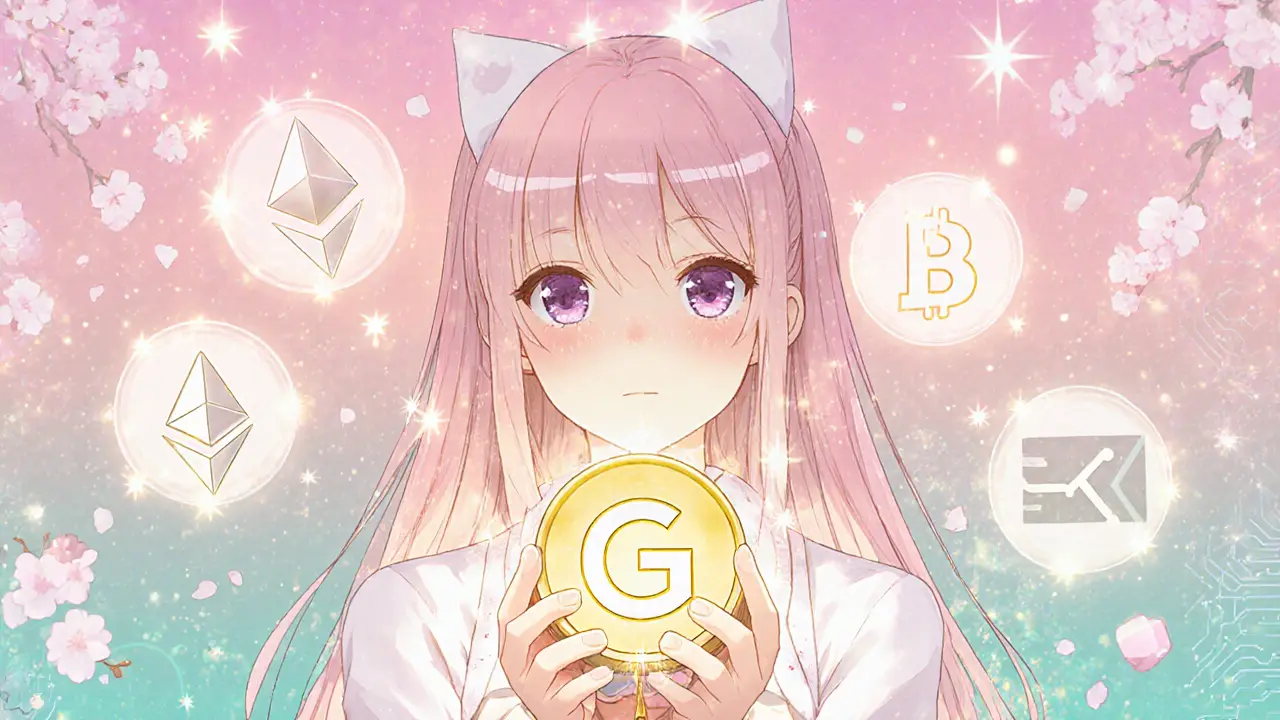Gravity (G) Token Calculator
Token Information
Staking Earnings Calculator
Estimated Annual Earnings
G staked at % annual reward = USD per year
Token Distribution Across Networks
| Network | Supply | Key Allocation |
|---|---|---|
| Ethereum | 10 billion G | Public sale, ecosystem fund, staking rewards |
| BNB Chain | 2 billion G | Strategic partners, liquidity mining |
| Base | 0 (bridged from other chains) | Future cross-chain bridges |
Quick Summary
- Gravity G token is the native coin of the Gravity blockchain and the utility token for the Galxe Web3 suite.
- It runs on Ethereum, BNB Chain and Base via cross‑chain bridges.
- Uses a hybrid "Gravitational Consensus" model that mixes Proof‑of‑Stake and Proof‑of‑Work.
- G fuels transaction fees, staking, governance (G DAO) and pays for services on Galxe Quest, Passport, Shop, Earn and more.
- Current price is around $0.010USD with a 24‑hour volume over $4million.
What Is Gravity (G) and Who Created It?
When you hear Gravity (G) is a blockchain‑based cryptocurrency developed by Galxe that serves as both the native token for the Gravity blockchain network and the utility token for the broader Galxe Web3 ecosystem. In plain English, it’s a single coin that works in two places at once: the underlying Gravity chain and the suite of Galxe‑branded dApps.
Galxe, the company behind the token, started as a Web3 identity‑management platform. By launching Gravity, they wanted to create an "one token, two ecosystems" model that ties together chain‑level infrastructure with real‑world app usage.
Supply, Distribution, and Cross‑Chain Reach
The token’s total supply is split across three major networks. Below is a snapshot of the allocations as of October2025:
| Network | Supply | Key Allocation |
|---|---|---|
| Ethereum | 10billion G | Public sale, ecosystem fund, staking rewards |
| BNB Chain | 2billion G | Strategic partners, liquidity mining |
| Base | 0 (bridged from other chains) | Future cross‑chain bridges |
The bridge‑first approach means Base users can still access G without a native issuance, keeping the overall tokenomics simple.
Technical Architecture: How Gravity Works Under the Hood
Gravity’s engineering is built around a metaphorical yet functional concept called "gravitational principles." The core components are:
- Gravitational Consensus: A hybrid mechanism that blends Proof‑of‑Stake (PoS) and Proof‑of‑Work (PoW). PoS handles validator rotation, while PoW adds a computational‑difficulty layer that deters short‑term attacks.
- Orbital Scaling: A layer‑2 solution that automatically expands throughput as more users join, much like orbital paths accommodate more satellites without collisions.
- G‑Force Framework: The proprietary smart‑contract language that lets developers embed token‑omics "gravity" directly into dApps, allowing incentives to be tied to network‑wide forces.
These three pillars aim to balance speed, security, and decentralization while keeping energy use lower than pure PoW chains.

Utility Across Two Ecosystems
Gravity (G) isn’t just a gas token; it wears several hats:
- Transaction fees: Every on‑chain operation on Gravity Chain costs G, similar to ETH on Ethereum.
- Staking: Holders can lock G to become validators, earn a share of transaction fees, and gain voting power in the G DAO.
- Governance: The G DAO is a decentralized autonomous organization where G holders vote on protocol upgrades, fund allocations, and ecosystem grants operates on‑chain, ensuring transparent decision‑making.
- Galxe application fees: Every Galxe product-Quest, Passport, Score, Alva, Shop, Earn-accepts G for payment, reducing friction for users who already hold the token.
Because the same coin powers both the base layer and the application layer, demand can come from two distinct user groups: developers building on Gravity and end‑users interacting with Galxe services.
Adoption Programs: Genesis of Gravity and Fragment NFTs
The most visible community‑growth engine is the "Genesis of Gravity event that runs a series of NFT quests, rewarding participants with rare and ultra‑rare fragment NFTs. Participants complete quests, collect NFTs, and open Mystery Boxes that contain:
- Rare Fragment NFTs - guarantee future rewards.
- Ultra‑Rare Fragment NFTs - higher‑value rewards and priority access.
- Galxe Plus one‑month subscriptions - exclusive perks for original minters.
These fragment NFTs are tradable, creating a secondary market that continually fuels demand for G because rewards are paid out in the native token.
Market Position, Risks, and Competitive Landscape
With a #363 ranking on CoinMarketCap and a 24‑hour volume of roughly $4.4million, Gravity sits in a mid‑tier liquidity bracket. Its dual‑ecosystem strategy differentiates it from single‑purpose tokens like Polygon (MATIC) or Solana (SOL) that focus mainly on network fees.
Key advantages:
- Broad utility across infrastructure and applications.
- Cross‑chain presence on Ethereum, BNB Chain, and Base.
- Active community incentives through Genesis of Gravity.
Primary risks include:
- Adoption dependence: G’s value hinges on both Gravity Chain usage and Galxe app traffic.
- Technical complexity: Hybrid consensus and Orbital Scaling are still relatively new and may encounter unforeseen bugs.
- Market volatility: Mid‑cap tokens can experience sharp price swings during broader crypto downturns.
How to Acquire, Store, and Stake G
Here’s a step‑by‑step guide for newcomers:
- Set up a non‑custodial wallet that supports Ethereum and BNB Chain (e.g., MetaMask, Trust Wallet).
- Visit a reputable exchange that lists G (such as Binance, KuCoin, or Gate.io) and purchase the amount you want.
- Transfer the tokens to your wallet. If you bought on BNB Chain, make sure you’re on the BSC network in your wallet.
- To stake, go to the official Gravity staking portal, connect your wallet, and delegate the desired amount to a validator node.
- After staking, you’ll start earning a share of transaction fees plus any bonus rewards from the G DAO’s community programs.
Remember to keep a small amount of G in your wallet for transaction gas when moving between networks.
Future Outlook and What to Watch
Galxe has outlined several milestones for the next 12‑24 months:
- Full decentralization of the G DAO with on‑chain voting modules.
- Expansion of Orbital Scaling to support sub‑second finality for high‑frequency dApps.
- Launch of new Galxe products that will exclusively accept G for premium features.
- Integration of additional L1/L2 chains (e.g., Avalanche, Polygon) via bridges.
If these roadmap items deliver, demand for G could grow from both developer incentives and end‑user utility, potentially tightening the token’s supply‑demand balance.

Frequently Asked Questions
What is the main purpose of Gravity (G) token?
G functions as both the gas fee token for the Gravity blockchain and the utility token for Galxe’s suite of Web3 applications, covering transactions, staking, governance, and service payments.
How does Gravitational Consensus differ from pure PoS or PoW?
It combines validator rotation (PoS) with a lightweight computational challenge (PoW). The PoS layer selects who creates blocks, while PoW adds an extra security barrier that makes short‑term attacks more costly.
Can I stake G on any blockchain?
Staking is currently supported on the Gravity mainnet, which is accessible via Ethereum and BNB Chain bridges. You must lock G through the official staking portal or a trusted validator dashboard.
What are Fragment NFTs and why do they matter?
Fragment NFTs are rewards from the Genesis of Gravity quests. Holding them guarantees future token drops and exclusive access to mystery boxes, creating a direct incentive to accumulate and trade G.
Is Gravity (G) a good long‑term investment?
Long‑term prospects depend on two factors: adoption of the Gravity blockchain by developers and continued use of Galxe’s applications. If both grow, G’s utility‑driven demand could support price appreciation, but the token remains subject to typical crypto market volatility.


Christina Lombardi-Somaschini
September 11, 2025 AT 08:59Thank you for the detailed breakdown of the Gravity (G) token. It’s helpful to see the current price and volume alongside the supply distribution across Ethereum and BNB Chain. I appreciate the clear table that outlines each network’s allocation, which makes the ecosystem’s structure more transparent. The ranking on CoinMarketCap also provides a quick benchmark for its market position. Overall, this post offers a solid snapshot for anyone looking to understand G token fundamentals.
katie sears
September 11, 2025 AT 17:13The token’s staking calculator appears user‑friendly, yet it would benefit from including real‑world examples of annual returns. For instance, demonstrating how a $1,000 investment translates into G tokens after staking could guide newcomers. Additionally, highlighting any lock‑up periods or penalties would add necessary nuance. I also wonder about cross‑chain bridges; a brief note on the future Base integration would be valuable. Your article lays a strong foundation, and these tweaks could elevate it further.
Gaurav Joshi
September 12, 2025 AT 00:10The G token’s low price raises suspicion about its long‑term viability. Investors should scrutinize the tokenomics before committing funds.
Kathryn Moore
September 12, 2025 AT 07:06Its supply is huge and that hurts price.
Christine Wray
September 12, 2025 AT 14:03I like the balanced approach of distributing G across multiple chains; it reduces single‑point risk and enhances accessibility. The inclusion of strategic partners on BNB Chain is a smart move for liquidity. It will be interesting to watch how the ecosystem fund supports developer initiatives. Overall, the token seems positioned for gradual growth rather than speculative spikes.
roshan nair
September 12, 2025 AT 21:00Great spot on the cross‑chain considerations! From my experience, tokens that diversify across Ethereum, BNB, and emerging layers tend to attract broader user bases. The public sale allocation on Ethereum should fuel early adoption, while the ecosystem fund can back innovative dApps. Remember that staking rewards often hinge on network congestion, so keeping an eye on gas fees is wise. Also, the upcoming Base bridge could unlock new liquidity streams, which might boost the token’s utility. Lastly, watch out for any governance proposals that could reshape token distribution.
Jay K
September 13, 2025 AT 03:56Structuring the supply this way shows prudent planning. It’s encouraging to see the emphasis on staking rewards which can cement community loyalty. However, potential investors should remain vigilant about the token’s market depth.
Kimberly M
September 13, 2025 AT 10:53👍 Absolutely love the clarity of the table! It makes it super easy to compare networks. Thanks for the effort! 😊
Navneet kaur
September 13, 2025 AT 17:50i think the token is just a hype train and many people will loose money. be careful dont trust everything you read. this is just my opinion but i think it will crash definitely.
Marketta Hawkins
September 14, 2025 AT 00:46Well, if you’re from the US you should support domestic crypto projects first :) Anyway, the G token looks like a decent entry point, but don’t get too excited. It’s not a miracle.
Drizzy Drake
September 14, 2025 AT 07:43Wow, this post really opened my eyes to the nuances of the Gravity (G) token. First off, the price point at a penny makes it feel accessible, but that also means volatility can be off the charts, especially when you factor in the 24‑hour volume of $4.4M – that’s not insignificant for a token of this size. The distribution across Ethereum and BNB Chain is smart; having 10 billion tokens on Ethereum gives it a solid base, while the 2 billion on BNB is likely a move to tap into the lower fees and faster transaction speeds there. I’ve seen similar strategies work well, especially when the ecosystem fund backs developer grants, which can create real utility beyond just speculative trading.
When you look at staking, the annual reward rate is a key metric – a generous percentage can attract long‑term holders, but you also have to watch out for inflationary pressure that could dilute the token’s value over time. The calculator included in the article is a neat tool, but remember that the actual earnings will depend heavily on network congestion and gas fees, particularly on Ethereum.
Another thing to watch is the upcoming Base bridge. Even though it currently lists a zero supply, the potential for cross‑chain liquidity could be a game‑changer, opening doors to new markets and possibly increasing demand for G. It’s the kind of forward‑looking feature that can differentiate a token in a crowded space.
From a risk perspective, the token’s ranking at #363 on CoinMarketCap tells you it’s still relatively low‑profile. That can be a double‑edged sword: on one hand, there’s room for growth; on the other, the lack of widespread recognition can mean lower liquidity and higher susceptibility to market swings.
If you’re considering an investment, it might be prudent to allocate a modest portion of your portfolio, treat it as a high‑risk, high‑potential asset, and keep an eye on any governance proposals that could affect token supply or staking mechanics. Also, stay updated on community channels for any announcements about partnerships or new use‑cases; those can dramatically shift sentiment.
Overall, Gravity (G) seems to be building a solid foundation with thoughtful tokenomics and a clear focus on cross‑chain flexibility. It’s not a guaranteed win, but for those willing to navigate the inherent volatility, it could be a rewarding addition to a diversified crypto portfolio.
AJAY KUMAR
September 14, 2025 AT 14:40Hold on! This G token is just another ploy by the big crypto elites to keep us all in check. They’re trying to paint it as a revolutionary cross‑chain solution, but in reality it’s just another way to funnel money into their pockets. Don’t be fooled by fancy tables and calculators – it’s all smoke and mirrors. The only drama here is the hype machine that’s been set into overdrive! Stay vigilant.
bob newman
September 14, 2025 AT 21:36Ah, the classic “look at the pretty charts” trick. As if the tokenomics alone can guarantee success. You know, the real story is hidden in the code, not the marketing fluff. If you’re not reading the whitepaper, you might as well be buying magic beans. Just saying.
Anil Paudyal
September 15, 2025 AT 04:33Nice summary, I think the token has potential but wathc out for volitilty.